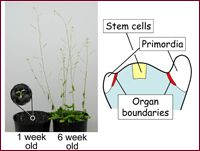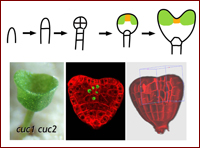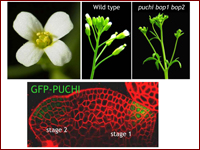Developmental Morphology Research Group
Group Member
 Assoc. Prof. Mitsuhiro Aida
Assoc. Prof. Mitsuhiro Aida

Figure 1.
Left: Arabidopsis plants at different ages
Right: Structure of the shoot meristem

Figure 2.
Top: Arabidopsis embryogenesis. orange, shoot meristem; green, cotyledon.
Bottom (from left to right): Seedling of the cuc1 cuc2 mutant, expression of a CUC1 target gene at the cotyledon boundary (green), 3D-reconstruction image of an embryo.

Figure 3.
Top (from left to right): Wild type flower, wild type inflorescence, puchi bop1 bop2 triple mutant inflorescence.
Bottom: Visualization of GFP-PUCHI fusion protein accumulating in early floral meristems (green).
Summary
In contrast to animals, in which majority of the organogenic events are limited to embryogenesis, plants continuously produce organs throughout their lifetime. The form of the adult plant is thus greatly different from that of the juvenile seedling (Fig.1). The plant form can also vary among individuals grown under different environmental conditions. Such flexible patterns in plant development are largely dependent on the activity of small undifferentiated tissues called the meristems, which are located at the tips of the plant body. Among the several types of the meristems, the shoot meristem is responsible for the production of most aerial part. The self-maintaining ability of the meristem is remarkable and in some species of conifers, for example, the meristem activity can last for thousands of years. The aim of our group is to understand key molecular and cellular mechanisms that control the activity of this fascinating tissue of plants, using the model plant Arabidopsis thaliana.
Main research project
- 1. Molecular mechanisms of shoot meristem initiation
- During embryogenesis, the shoot meristem is initiated between two cotyledon primordia (Fig 2). We focus on the function of the CUC1, CUC2, and CUC3 genes, which encodes NAC transcription factors essential for shoot meristem initiation. These genes are expressed in cells along the shoot organ boundaries, the sites generally posses high potential to produce new shoot meristems. Besides promoting meristem initiation, the CUC genes also act to prevent fusion of adjacent shoot organs, possibly through regulating patterns of cell division and elongation along the organ boundaries. By analyzing genes acting downstream of the CUC genes, we are uncovering a regulatory network that is responsible for shoot meristem initiation and organ separation.
- 2. Molecular mechanism of flower development
- Angiosperms (flowering plants) are the most diverse group of land plants. The success of this group partly comes from the invention of the flower, a highly specialized organ system dedicated for reproduction. Floral organs are generated from a specialized type of the meristem called the floral meristem, whose activity differs in many ways from that of the shoot meristem. We found that the AP2 transcription factor PUCHI, together with the transcriptional coactivators BOP1 and BOP2, is involved in specification of floral meristems, possibly through activating the expression of the LFY gene, a central regulator for meristem identity (Fig 3). Further studies on the function of PUCHI are in progress.
Selected literature
- Takeda, S. et al., Plant J doi: 10.1111/j. 1365-313X.2011.04571.x., 2011. [PubMed]
- Takeda, S. & Aida, M., J Plant Res 124, 211-219, 2011. [PubMed]
- Takano, S. et al., Plant Cell Physiol 51, 621-634, 2010. [PubMed][Cover photo]
- Karim, M. et al., Plant Cell, 21, 1360-1372, 2009. [PubMed][See also] [And also]
- Aida, M. & Tasaka, M., Curr Opin Plant Biol, 9, 72-77, 2006. [PubMed]
- Aida, M. & Tasaka, M., Plant Mol Biol, 60, 915-928, 2006. [PubMed]
- Furutani, M. et al., Development, 131, 5021-5030, 2004.[PubMed][Cover photo]
- Aida, M. et al., Cell, 119, 109-120, 2004. [PubMed]
- Aida, M. et al., Development, 129, 3965-3974, 2002. [PubMed]
- Aida, M. et al., Development, 126, 1563-1570, 1999. [PubMed]
- Aida, M. et al., Plant Cell, 9, 841-857, 1997. [PubMed]
